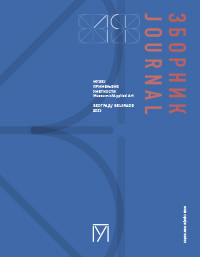Zbornik 19 / 2023 (Muzej primenjene umetnosti. Online)

ISSN 2466-460X (Online)
ISSN 0522-8328 (Štampano izdanje)
PDF štampanog izdanja ![]() (9.8 MB)
(9.8 MB)
Glavni i odgovorni urednik: Biljana Jotić
Urednik broja: Biljana Crvenković, Mila Gajić
Uređivački odbor:
dr Nikola Šuica (Univerzitet u Beogradu, Fakultet likovnih umetnosti, Beograd)
dr Maja Stanković (Univerzitet Singidunum, Fakultet za medije i komunikacije, Beograd)
dr Vladana Putnik Prica (Univerzitet u Beogradu, Filozofski fakultet, Beograd)
mr Slađana Petrović Varagić (istoričarka umetnosti, Požega)
Biljana Jotić (Muzej primenjene umetnosti, Beograd)
Mila Gajić (Muzej primenjene umetnosti, Beograd)
Biljana Crvenković (Muzej primenjene umetnosti, Beograd)
Sekretar redakcije broja: Ana Samardžić
Svi tekstovi u rubrikama Prilozi, Polemike, Kritike i Prikazi se recenziraju.dr Dragana Pavlović, docent, Univerzitet u Beogradu, Filozofski fakultet – Odeljenje za istoriju umetnosti
mr Jelena Perać, muzejska savetnica, Muzej primenjene umetnosti, Beograd
Prof. dr Milan Popadić, redovni profesor, Univerzitet u Beogradu, Filozofski fakultet – Odeljenje za istoriju umetnosti
dr Bojan Popović, muzejski savetnik, Narodni muzej, Beograd
mr Bojana Popović, muzejska savetnica, Muzej primenjene umetnosti, Beograd
Jelena Popović, viša kustoskinja, Muzej primenjene umetnosti, Beograd
ma Una Popović, viša kustoskinja, Muzej savremene umetnosti, Beograd
dr Milan Prosen, docent, Univerzitet umetnosti u Beogradu, Fakultet primenjenih umetnosti – odsek: Istorija umetnosti
Sadržaj Zbornika 19 / 2023 (Muzej primenjene umetnosti. Online)
Impressum
Contents
About Journal
INTERIORS BY DUŠAN JANKOVIĆ
Translated by Tatjana Nišić
THE WORK OF FASHION DESIGNER MILORAD MIKI IGNJIĆ (1942–2017)
Translated by the author
BITI NEGATIV(AN): BAUCI SOCIJALIZMA U FOTOGRAFSKIM ARHIVAMA
THE TRANSFORMATION OF CERAMIC PAINTING
Translated by the author
THE THREE DRESSES IN THE MUSEUM: MUSEUM THESAURI AND FASHION IN SERBIA IN THE 19TH AND EARLY 20TH CENTURIES
Translated by the author
HEADDRESS ON THE KTITOR’S PORTRAIT OF THE CHURCH OF THE VIRGIN MARY IN DONJA KAMENICA
Translated by the author
THE HETEROGENEOUS OPUS OF JOVAN J. PEŠIĆ IN THE GRAPHIC COLLECTION OF THE NATIONAL LIBRARY OF SERBIA
Translated by the author
ARTISTIC AND HISTORICAL DEVELOPMENT OF THE GLASS FACTORY UKRAS FROM ALIBUNAR (1967–2009)
Translated by the author
LIST OF REVIEWERS
